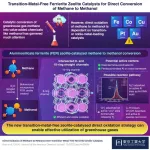Transition-metal-free zeolite catalyst for direct conversion of methane to methanol
Researchers present aluminosilicate ferrierite zeolite catalyst as a promising material for carrying out the conversion reaction
2024-06-03
(Press-News.org)
In light of the waste-to-wealth movement, technology for converting greenhouse gases into value-added materials has gained significant attention in recent years. One such technology is the catalytic conversion of methane into methanol, a widely used industrial solvent and raw material for chemical synthesis. The industrial process for conversion of methane to methanol is extremely energy and resource-intensive. In the past decade, scientists have developed several catalyst systems that can enable direct oxidation of methane to methanol. However, most of them are based on rare and expensive transition or noble metals.
In a recent study, a group of researchers, led by Associate Professor Toshiyuki Yokoi and including Assistant Professor Peipei Xiao, both from the Nanospace Catalysis Unit of the Institute of Innovative Research at Tokyo Institute of Technology, Japan, found a solution to the existing problem in the form of transition-metal-free aluminosilicate ferrierite (FER) zeolite. FER is a 2-dimensional zeolite with 8-ring channels and intersected 10-ring channels known to be highly stable towards chemical and thermal treatments. Taking advantage of this unique structural property, Yokoi and his team demonstrated for the first time the direct oxidation of methane to methanol using nitrous oxide as the source of oxygen. The findings of this study were made available online on April 1, 2024, and published in the Journal of the American Chemical Society on April 10, 2024.
“Transition-metal exchanged zeolites have widely been used in gas- and liquid-phase reaction systems. Such moieties have been reported to have active sites inspired by natural biocatalytic enzyme systems. While the catalysts with transition-metal loading are quite popular, zeolite catalysts consisting of only main group elements for direct oxidation of methane to methanol remained unexplored,” remarks Yokoi when asked about the motivation behind developing FER zeolites.
To get a clear picture of the active sites in the zeolite catalyst, the team conducted Fourier transform infrared spectroscopy (FTIR) and magnetic resonance spectroscopy. The tests revealed distorted tetracoordinated Al in the framework and pentacoordinated Al in the extra framework formed during the activation, calcination, and reaction processes. These structures were established as potential active centers. The team also probed the possible reaction pathway with the help of nitrous oxide adsorption FTIR spectra and observation of reaction performances under different oxidants. They found that the process began with the absorption of nitrous oxide on the active Al sites and the formation of “α-O” leading to the release of nitrogen. This was followed by the adsorption of methane on the active “α-O” sites and the breaking of C−H bonds. After the bond breaking, methanol was obtained via desorption followed by recovery of the active Al species.
The new transition-metal-free zeolite-catalyzed direct oxidation process enabled 305 μmol g−1 min−1 methanol production rate with 89% methanol and 10% dimethyl ether selectivity, thus, recording one of the highest performances reported in the literature, even better than many transition metal-loaded catalysts.
“Our findings will open up a brand-new avenue for the development of direct oxidation of methane to methanol on transition-metal-free aluminosilicate zeolites, thus enabling the utilization of methane and nitrous oxide to other useful chemicals on aluminosilicate zeolites with different topological structures,” adds Yokoi, describing the real-life implications of their research.
Overall, the new strategy proposed in this study can create a positive environmental impact by reducing the amount of greenhouse gases circulating in the atmosphere and adding to the economy by facilitating the synthesis of valuable chemicals from unwanted raw materials.
###
About Tokyo Institute of Technology
Tokyo Tech stands at the forefront of research and higher education as the leading university for science and technology in Japan. Tokyo Tech researchers excel in fields ranging from materials science to biology, computer science, and physics. Founded in 1881, Tokyo Tech hosts over 10,000 undergraduate and graduate students per year, who develop into scientific leaders and some of the most sought-after engineers in industry. Embodying the Japanese philosophy of “monotsukuri,” meaning “technical ingenuity and innovation,” the Tokyo Tech community strives to contribute to society through high-impact research.
https://www.titech.ac.jp/english/
END
[Attachments] See images for this press release:

ELSE PRESS RELEASES FROM THIS DATE:
2024-06-03
CLEVELAND—A new study by researchers at the Case Western Reserve University School of Medicine reveals that the popular diabetes and weight-loss drugs Wegovy and Ozempic are linked to reduced incidence and recurrence of alcohol abuse or dependence.
The team’s findings, recently published in the journal Nature Communications, may suggest a possible new treatment for excessive alcohol use—including alcohol-use disorder (AUD), a health condition that causes about 178,000 deaths in the United States each year, according to the Centers for Disease Control.
To date, the U.S. Food and Drug Administration ...
2024-06-03
(LOS ANGELES) June 3, 2024 – Scientists at the Terasaki Institute for Biomedical Innovation (TIBI), have employed artificial intelligence techniques to improve the design and production of nanofibers used in wearable nanofiber acoustic energy harvesters (NAEH). These acoustic devices capture sound energy from the environment and convert it into electrical energy, which can then be applied in useful devices, such as hearing aids.
Many efforts have been made to capture naturally occurring and abundant energy sources ...
2024-06-03
June 3, 2024 (Rockville, MD)
The National Foundation for Cancer Research (NFCR) is announcing that the blue-ribbon selection committee, composed of world-renowned research leaders and visionaries, has awarded the 2024 Szent-Györgyi Prize for Progress in Cancer Research to Dennis J. Slamon, M.D., Ph. D. from UCLA Health for his groundbreaking research discoveries that helped to shape the field of precision medicine for breast cancer patients.
The cancer research community will celebrate Dr. ...
2024-06-03
About The Study: This cohort study found that using decentralization through telemedicine and local care may substantially reduce cancer care’s greenhouse gas emissions; this corresponds to small reductions in human mortality.
Corresponding Author: To contact the corresponding author, Gregory A. Abel, M.D., M.P.H., email gregory_abel@dfci.harvard.edu.
To access the embargoed study: Visit our For The Media website at this link https://media.jamanetwork.com/
(doi:10.1001/jamaoncol.2024.2744)
Editor’s Note: Please see the article for additional information, including other authors, author contributions and affiliations, ...
2024-06-03
BOSTON – Telemedicine visits for cancer care may not only be more convenient and easier to schedule than in-person appointments, they're also better for the planet, new research by Dana-Farber Cancer Institute scientists shows.
Based on an analysis of data from a regional cancer center, the researchers calculate that, nationwide, cancer care that utilizes telehealth and local care would generate 33.1% less greenhouse gas emissions than the traditional model of in-person care, primarily because of reduced travel to medical appointments. ...
2024-06-03
The timing of our brain waves shapes how we perceive our environment. We are more likely to perceive events when their timing coincides with the timing of relevant brain waves. Lead scientist Sanne ten Oever and her co-authors set out to determine whether neural timing also shapes speech perception. Is the probability of speech sounds or words encoded in our brain waves and is this information used to recognise words?
The team first created ambiguous stimuli for both sounds and words. For instance, the initial sounds in da and ga differ in probability: ‘d’ is more common than ‘g’. The Dutch words dat “that” and gat “hole” ...
2024-06-03
About The Study: This quality improvement analysis of clinical trials for metastatic breast, lung, colon, pancreatic, and prostate cancers found that a large proportion of the U.S. population lived within 30 miles of a clinical trial site. This finding suggests that while many clinical trials are available, they are not evenly distributed across the country and may not be accessible to all individuals, particularly racial and ethnic minority individuals. This disparity in access to clinical trials raises important questions about equity and fairness in the distribution of health care resources and opportunities ...
2024-06-03
Portland State will power up a new high-performance computing cluster that will give researchers at universities and colleges across Oregon the ability to advance computing-intensive research projects by processing large datasets and performing complex computations in a fraction of the time — thanks to a nearly $1 million grant from the National Science Foundation’s Campus Cyberinfrastructure program.
The Oregon Regional Computing Accelerator (Orca) aims to provide free-of-cost computing resources and cyberinfrastructure ...
2024-06-03
It’s in your heart and liver, in the vegetables you eat, in the rogue cells that cause cancer. Those who live in temperate regions are surrounded by more of it than people who live in the tropics, and without it, humans wouldn’t exist.
It’s called polyploidy, and only within the last few years have biologists begun to recognize its significance across the tree of life.
“It’s one of the most important biological processes that hardly anybody knows about,” said Doug Soltis, a distinguished professor at the Florida Museum of Natural History.
Soltis is one of 18 scientists who have received a combined ...
2024-06-03
SAN ANTONIO — June 3, 2024 — Southwest Research Institute will enhance models to strengthen the earthquake resilience of America’s transportation infrastructure and improve public safety in earthquake-prone areas. As part of a contract with the U.S. Federal Highway Administration (FHWA), an SwRI-led team will update and improve liquefaction models. Liquefaction occurs during an earthquake when intense shaking causes soil to temporarily act more like a fluid, losing its capacity to support roads and structures.
“For highways specifically, sometimes state and ...
LAST 30 PRESS RELEASES:
[Press-News.org] Transition-metal-free zeolite catalyst for direct conversion of methane to methanol
Researchers present aluminosilicate ferrierite zeolite catalyst as a promising material for carrying out the conversion reaction





